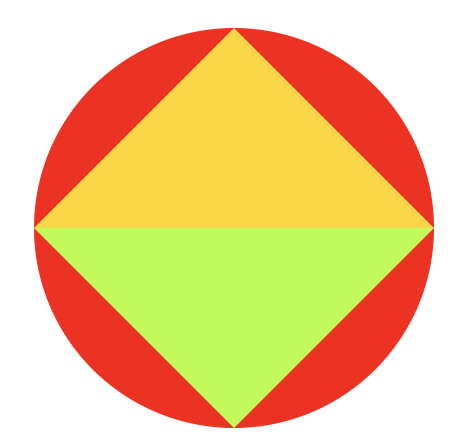# 来次Sass与Less的语法碰撞
这里的Sass使用dart-sass版,非node-sass或libSass。
# 第一关:变量
我们用分别用Less和Sass实现如下效果:

Sass实现:
$w200: 200px;
$h200: 200px;
.bg-red{
background-color: red;
}
.circle-radius {
border-radius: 50%;
}
.triangle {
&::before{
position: absolute;
content: '';
width: 0;
height: 0;
top: -50%;
border: 100px solid transparent;
border-bottom-color: gold;
}
}
@mixin mixin(){
&::after{
position: absolute;
content: '';
width: 0;
height: 0;
top: 50%;
border: 100px solid transparent;
border-top-color: greenyellow;
}
}
.sass .square{
position: relative;
width: $w200;
height: $h200;
@extend .bg-red;
@extend .circle-radius;
@extend .triangle;
@include mixin;
}
2
3
4
5
6
7
8
9
10
11
12
13
14
15
16
17
18
19
20
21
22
23
24
25
26
27
28
29
30
31
32
33
34
35
36
37
38
39
Less实现:
@w200: 200px;
@h200: 200px;
@bgRed: .bg-red;
@{bgRed}{
background-color: red;
}
@circleRadius:{
border-radius: 50%;
}
@triangle:{
&::before{
position: absolute;
content: '';
width: 0;
height: 0;
top: -50%;
border: 100px solid transparent;
border-bottom-color: gold;
}
}
.mixin(@extraStyle){
@extraStyle();
}
.less .square{
position: relative;
width: @w200;
height: @h200;
.bg-red;
@circleRadius();
@triangle();
.mixin({
&::after{
position: absolute;
content: '';
width: 0;
height: 0;
top: 50%;
border: 100px solid transparent;
border-top-color: greenyellow;
}
})
}
2
3
4
5
6
7
8
9
10
11
12
13
14
15
16
17
18
19
20
21
22
23
24
25
26
27
28
29
30
31
32
33
34
35
36
37
38
39
40
41
42
可以发现,
- Sass变量用$声明,用:赋值,变量只能是单位值、颜色两种;
- Less变量用@声明,用:赋值,变量可以是单位值、颜色、选择器、样式集合,还可以作为参数。
# 第二关:混入
有如下一段HTML,为第二、三个子元素加点颜色,
<div class="parent">
<div>one</div>
<div class="parent-second">two</div>
<div>three</div>
</div>
2
3
4
5
Sass实现:
@mixin no-output-mixin{
color: blueviolet;
}
@mixin output-mixin{
color: brown;
}
.sass .parent{
&>div:nth-child(3){
@include no-output-mixin;
}
&-second{
@include output-mixin;
}
}
2
3
4
5
6
7
8
9
10
11
12
13
14
Less实现:
.no-output-mixin(){
color: blueviolet;
}
.output-mixin{
color: brown;
}
.less .parent{
& > div:nth-child(3){
.no-output-mixin();
}
&-second{
.output-mixin;
}
}
2
3
4
5
6
7
8
9
10
11
12
13
14
为了语法糖容易比较,特意代码上保持命名一致,
- Less混入声明跟使用CSS方式相同,引用则指定选择器名称。它分无输出混入(后面带括号)、有输出混入(后面不带括号),这个输出可理解为编译后的CSS文件中是否包含样式;
- Sass通过@mixin定义,@include应用,相较于less,只有无输出混入;
- 顺带一提,Sass和Less都支持父选择器&。
拓展:Sass和Less的混入都支持带不定参数
举个例子,自定义一个盒子的宽度、高度、边框
/* Sass */
@use "sass:list" as list;
@mixin no-certain-mixin($size, $rest...) {
width: $size;
height: $size;
border: list.nth($rest, 1) list.nth($rest, 2) list.nth($rest, 3);
}
.sass .rest{
@include no-certain-mixin(200px, 1px, dashed, blue);
}
/* Less */
.no-certain-mixin(@size; @rest...) {
width: @size;
height: @size;
border: @rest;
}
.less .rest{
.no-certain-mixin(200px, 1px, dashed,blue);
}
2
3
4
5
6
7
8
9
10
11
12
13
14
15
16
17
18
19
20
会发现,less实现简单,sass需要内置模块list配合实现。less的不定参数设计是考虑作为一个整体使用,而sass的不定参数则灵活些,但牺牲了使用的复杂度。
# 第三关:嵌套
搞一个基础的列表样式,
Sass实现:
.sass .container{
ul{
list-style: none;
li{
border-bottom: 1px dashed gold;
span{
font-weight: bold;
}
}
}
}
2
3
4
5
6
7
8
9
10
11
Less实现:
.less .container{
ul{
list-style: none;
li{
border-bottom: 1px dashed gold;
span{
font-weight: bold;
}
}
}
}
2
3
4
5
6
7
8
9
10
11
嵌套的使用两者基本一致。
# 第四关:操作符
直接看一段代码,
@use "sass:math" as math;
.sass .box{
position: relative;
left: 50px - 10px;
width: 10px + 40px;
height: math.div(100px, 2);
padding: 30px - 2px;
border: (1px * 10) solid #880000;
background-color: #666;
}
2
3
4
5
6
7
8
9
10
.less .box{
position: relative;
left: 50px - 10%;
width: 10px + 40px;
height: (100px / 2);
padding: 30px - 2em;
border: (1px * 10) solid (red / 2);
background-color: #222 * 3;
}
2
3
4
5
6
7
8
9
实践发现:
- Sass提供以下操作符:==、!=、<、<=、>、>=、+、-、*、%、字符串连接符+、not、and、or。当不同单位间进行运算会报错,如果启动时带了watch选项,能实时监听语法错误,在终端和页面都有报错提示,非常友好。不支持除法运算符,推荐使用 math.div(100px, 2)。也不支持使用颜色作运算,可以考虑使用color.adjust函数(后面有提到);
- Less不同单位间的运算不报错,结果按第一个值的单位进行计算。建议使用同一种单位进行运算,以达预期效果。
# 第五关:继承
继承与混入的差异:继承的样式不会插入选择器,而是重新定义相同的选择器进行应用;混入的样式直接插入选择器。
有两个空心圆,代码如下,
.more{
border: 2px solid orange;
border-radius: 50%;
}
.sass .extend{
width: 100px;
height: 100px;
@extend .more;
}
.sass .extend2{
width: 100px;
height: 100px;
@extend .more;
}
2
3
4
5
6
7
8
9
10
11
12
13
14
.more{
border: 2px solid orange;
border-radius: 50%;
}
.less .extend{
width: 100px;
height: 100px;
&:extend(.more);
}
.less .extend2:extend(.more){
width: 100px;
height: 100px;
}
2
3
4
5
6
7
8
9
10
11
12
13
可以看出,Sass与Less只是语法糖上的不同,无太大差异。Less支持两种写法,实现选择器继承。
# 第六关:流程控制
Sass提供了循环控制如@each、@for、@while,也提供了条件控制如@if、@else、@else-if。
Less提供了守卫when和if。
在这拿@while和when做个实现比较。页面结构如下,
<div class="loop">
<span class="item-1">第一名</span>
<span class="item-2">第二位</span>
<span class="item-3">第三个</span>
<span class="item-4">第四只</span>
<span class="item-5">第五批</span>
<span class="item-6">第六感</span>
</div>
2
3
4
5
6
7
8
实现如下效果,

@use "sass:math" as math;
@use "sass:color" as color;
@mixin handler($num, $i: 1) {
@while $i <= $num {
.item-#{$i} {
color: color.adjust(#ff0000, $red: math.div(-255, $i) * ($i - 1), $green: 0, $blue: 0);
font-size: 12px + $i;
}
$i: $i + 1;
}
}
.sass .loop{
@include handler(6)
}
2
3
4
5
6
7
8
9
10
11
12
13
14
.handler(@num, @i: 1) when (@i =< @num) {
.item-@{i}{
color: (red / @i);
font-size: 12px + @i;
}
.handler(@num, (@i+ 1));
}
.less .loop{
.handler(6)
}
2
3
4
5
6
7
8
9
10
可以看出,Sass和Less在流程控制写法有些差异,Sass写法比较贴近我们的JS编程,而Less是when + “递归”的写法,看起来不大习惯。个人认为,Sass在这块设计上比Less好些。细心的同学应该也注意到,两者都支持插值。
拓展:我们的效果每轮询一次,颜色值变为上一次的一半,字体大小比上一次大1px,字体大小没什么好说的,由于less支持颜色值和除法运算符,实现非常直观,而Sass实现需要借助color.adjust函数,并自行实现算法。
当然,以上并非全部。还有导入、作用域、注释,不过它们在两者之间基本一致,也比较简单,就不列举了。
它们也有自己的特性,比如Sass提供了内置模块,上面示例其实也有所体现,通过@use规则引入;支持partials,即导入以_开头的sass文件不会被打包,常用来放置一些工具函数或mixin等;内置了关于数值、字符串、颜色、Lists、Maps、计算等各类函数,并支持自定义,这点less不支持自定义函数;还提供了@at-root(用于全局样式)、@error、@warn、@debug(日志打印)、@forward(效果犹如@use+@extend的结合?)。转而,Less有自己的命名空间和访问器、合并+/+_(属性值合并)、插件@plugin(通过JS做更多扩展)等。
以上,只是对常用的语法糖进行大体比较。想对二者更深入了解,可上官网进行学习。
最后个人看法:Sass与Less对比下来,编码量相近,但Less语法糖比较杂,Sass语法糖比较规范,自由度更高,扩展性也不错。个人认为Sass设计好于Less。
